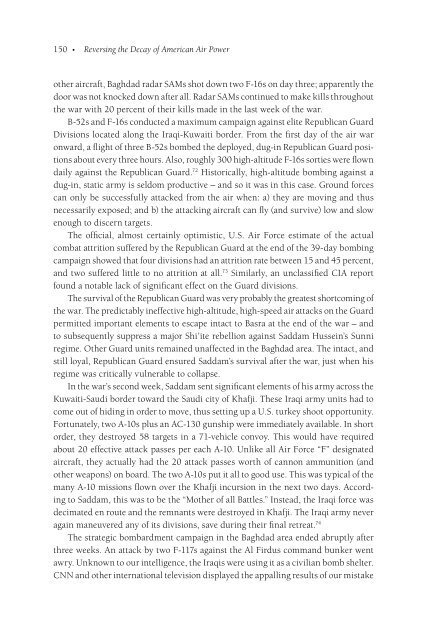Americas Defense Meltdown - IT Acquisition Advisory Council
Americas Defense Meltdown - IT Acquisition Advisory Council
Americas Defense Meltdown - IT Acquisition Advisory Council
Create successful ePaper yourself
Turn your PDF publications into a flip-book with our unique Google optimized e-Paper software.
150 • Reversing the Decay of American Air Powerother aircraft, Baghdad radar SAMs shot down two F-16s on day three; apparently thedoor was not knocked down after all. Radar SAMs continued to make kills throughoutthe war with 20 percent of their kills made in the last week of the war.B-52s and F-16s conducted a maximum campaign against elite Republican GuardDivisions located along the Iraqi-Kuwaiti border. From the first day of the air waronward, a flight of three B-52s bombed the deployed, dug-in Republican Guard positionsabout every three hours. Also, roughly 300 high-altitude F-16s sorties were flowndaily against the Republican Guard. 72 Historically, high-altitude bombing against adug-in, static army is seldom productive – and so it was in this case. Ground forcescan only be successfully attacked from the air when: a) they are moving and thusnecessarily exposed; and b) the attacking aircraft can fly (and survive) low and slowenough to discern targets.The official, almost certainly optimistic, U.S. Air Force estimate of the actualcombat attrition suffered by the Republican Guard at the end of the 39-day bombingcampaign showed that four divisions had an attrition rate between 15 and 45 percent,and two suffered little to no attrition at all. 73 Similarly, an unclassified CIA reportfound a notable lack of significant effect on the Guard divisions.The survival of the Republican Guard was very probably the greatest shortcoming ofthe war. The predictably ineffective high-altitude, high-speed air attacks on the Guardpermitted important elements to escape intact to Basra at the end of the war – andto subsequently suppress a major Shi’ite rebellion against Saddam Hussein’s Sunniregime. Other Guard units remained unaffected in the Baghdad area. The intact, andstill loyal, Republican Guard ensured Saddam’s survival after the war, just when hisregime was critically vulnerable to collapse.In the war’s second week, Saddam sent significant elements of his army across theKuwaiti-Saudi border toward the Saudi city of Khafji. These Iraqi army units had tocome out of hiding in order to move, thus setting up a U.S. turkey shoot opportunity.Fortunately, two A-10s plus an AC-130 gunship were immediately available. In shortorder, they destroyed 58 targets in a 71-vehicle convoy. This would have requiredabout 20 effective attack passes per each A-10. Unlike all Air Force “F” designatedaircraft, they actually had the 20 attack passes worth of cannon ammunition (andother weapons) on board. The two A-10s put it all to good use. This was typical of themany A-10 missions flown over the Khafji incursion in the next two days. Accordingto Saddam, this was to be the “Mother of all Battles.” Instead, the Iraqi force wasdecimated en route and the remnants were destroyed in Khafji. The Iraqi army neveragain maneuvered any of its divisions, save during their final retreat. 74The strategic bombardment campaign in the Baghdad area ended abruptly afterthree weeks. An attack by two F-117s against the Al Firdus command bunker wentawry. Unknown to our intelligence, the Iraqis were using it as a civilian bomb shelter.CNN and other international television displayed the appalling results of our mistake


